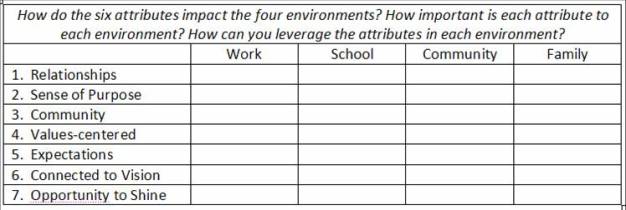Engagement efforts are mostly focused on employees and the workplace. That’s where the money is. Companies get impressive bottom line improvements if they understand and use the right engagement levers to turn the key that unlocks employees’ overdrive. Consultants get rich selling their unique engagement potions to companies that get richer and want more.
Not many consultants are making their mark helping boost student engagement in schools, or helping local governments increase citizen engagement and community involvement, or helping civic groups boost their membership’s engagement. What is the dollar impact of disengagement in those areas anyway? And what’s the payback for me as a consultant? Why bother?
None of those will pay the bills, Junior. Stick with “employee engagement”.
It’s rare you see something on “engagement” without the other “e” word-“employee”. But we’ve suboptimized the benefits and potential impact of engagement by focusing so much on how only workers are engaged. People are engaged when they are fully connected and committed to an endeavor or course of action, whatever the endeavor may be. They are willing and able to put extra effort into getting the job done and doing it well, whatever the job may be. Performance, goal attainment, individual satisfaction and well-being all get a boost from higher engagement in whatever the area may be.
Engagement is a game-changer for more than just the workplace. It applies to students, citizens, family members, and social / civic groups too.
Disengaged employees piddle around, complain too much about nothing and do just what they need to, to get by….almost. They’ll leave soon as they can find a more promising place to piddle around, a workplace where they can more freely whine.
That’s a little sarcasm, of course. Some companies and their leaders go out of the way to come up with stupid ways to disengage their employees, or they just don’t care. Those companies and leaders usually get what they deserve, or don’t get all that they could from their people.
Lost productivity and attrition are the heavy hitters, easy to put a value on. So the impact of employee disengagement is easy to measure. But how do you assign dollar impact to disengagement in those other areas? Consider the following symptoms:
- Disengaged students don’t care about their education. They tune out and under-perform. Worst case, they drop out of school. They see little promise for the future, little hope they have a chance of becoming anything but a bad statistic. The social and economic cost of student disengagement is huge, as is the tragedy and dollar amount of wasted potential.
- When a social or civic group’s membership is disengaged, the organization may simply cease to exist or become irrelevant. Nothing of any importance happens. Membership becomes little more than a token, obligatory gesture, an excuse to get out of the house.
- Disengaged citizens don’t bother to be informed or involved. What’s the point? Many of those who do vote don’t have the information they need to make good decisions. People don’t care about the community and it goes to hell physically. There is a steady rise in civil and legal problems, and an abundance of increasingly significant social issues. People can’t get the hell out of Dodge fast enough…if they can escape at all.
I’ve studied the more prevalent engagement models and identified the following attributes of an environment that supports high engagement. They are pretty much the same whether work, school, community or civic / social group. If you want more than my selection, study any engagement model. Better, look at several and find the common elements that support high engagement. These are mine.
Universal Attributes
- Relationships built on caring and trust: no matter our age we all need to be nurtured. Humans thrive when someone truly cares about them. Not about what they do or how much they do or how well they do it…but they actually care about US.
- Sense of Purpose: what makes you get up in the morning; being involved in something that matters long-term; making a difference in the grand scheme of things;
- Community: humans are social creatures and have been throughout history, banding together in tribes for safety and companionship. But it’s more than strength in numbers, more than birds-of-a-feather. We have a basic human need to be part of a group;
- Values-centered: we’re drawn to situations where our values are at least somewhat in alignment. We can experience considerable discomfort when our values are stifled or contradicted, even when we’re not aware of what our values are. We know something’s not right, we just don’t know what or why
- Clear Expectations and Feedback: we’re more willing to take a trip if there’s a roadmap for how to get from here to there. People are driven to make a meaningful contribution. They need to know they’re doing the right things and how they are doing real-time. Even better is if the destination is compelling, and if the route and the tasks to accomplish are…
- Connected to Vision: Moses didn’t just say “let’s go wander aimlessly in the desert for a few decades” even though that’s the way it turned out due to a major error in judgment. They set out for the Promised Land. Connecting to vision can be as simple as providing the “why” behind the “what” and having a line of sight from everyday tasks to the top goals of the organization.
- Opportunity to Shine: when people do what they do best and truly enjoy doing, they are likely to produce more exceptional results. Satisfaction and well-being skyrockets, leading to even more impressive performance. It’s a reinforcing loop and common sense too.
Most of the mainstream models concur: these are the heavy hitter levers of engagement. What do you think? Any to add?
The Acid Test: you may not have given much thought to them before but whether or not you know it those attributes affect you. As they are heavily influenced by values, relative importance varies person-to person. How important are each of the attributes to you? I put the attributes in priority order when I do my gut-check, highly recommended….
Personal Application: do a well-being check-up using the attributes when something changes in your environment or you’re bothered by something but not sure what’s wrong…or even if you are feeling especially energized. We’re prolific firefighters, we thrive on trouble-shooting problems. It can also be extremely valuable to assess the situation when things are going exceptionally well, so we know what to emulate to make more good stuff happen later.
Your Assignment: build a spreadsheet with the attributes as row titles and these four areas as column headers: Work; School; Community; Family. Describe how each of the attributes is relevant to each area, and how important each of the attributes are to each area. Last: how great is the impact of each attribute on each of the four areas?
Closing Thoughts
There is a physical and emotional buzz that comes with being highly engaged. It is both addicting and contagious. If you’re engaged at work, it’s more likely you’ll also be a highly engaged citizen and family member. Highly engaged students not only do better in school, they are also more likely to be highly engaged employees, have a happy and successful family life and will become involved, contributing, productive community members. Highly engaged family members and model citizens are typically model employees, successful in the private sector.
If you’re surrounded by highly engaged people you’re going to catch the bug from them, and others can catch it from you. But the reverse holds true too: disengagement is highly contagious, and crossover disengagement is an extremely destructive force. Again, it’s a reinforcing loop and common sense.
You cannot get through a single day without having an impact on the world around you. What you do makes a difference, and you have to decide what kind of difference you want to make. (Jane Goodall)
Good for What Ails Us
Engagement theory is well-known and has been heavily researched for years. The things that enable a high-engagement environment are also well-known, and their impacts well-validated.
Focusing only on employee engagement undermines impact potential. Engagement is contagious with a probability of crossover. Engagement-minded leaders have broader influence and impact than in just their primary sphere of influence. True for private sector, education or community.
Business leaders, government officials, education professionals, community and civic leaders—all would do well to understand the power of engagement, leverage the appropriate engagement attributes within their sphere of influence, and then reach further out.
It’s much more than employee engagement. It’s for the greater good.

